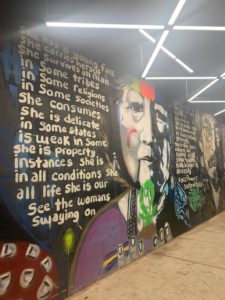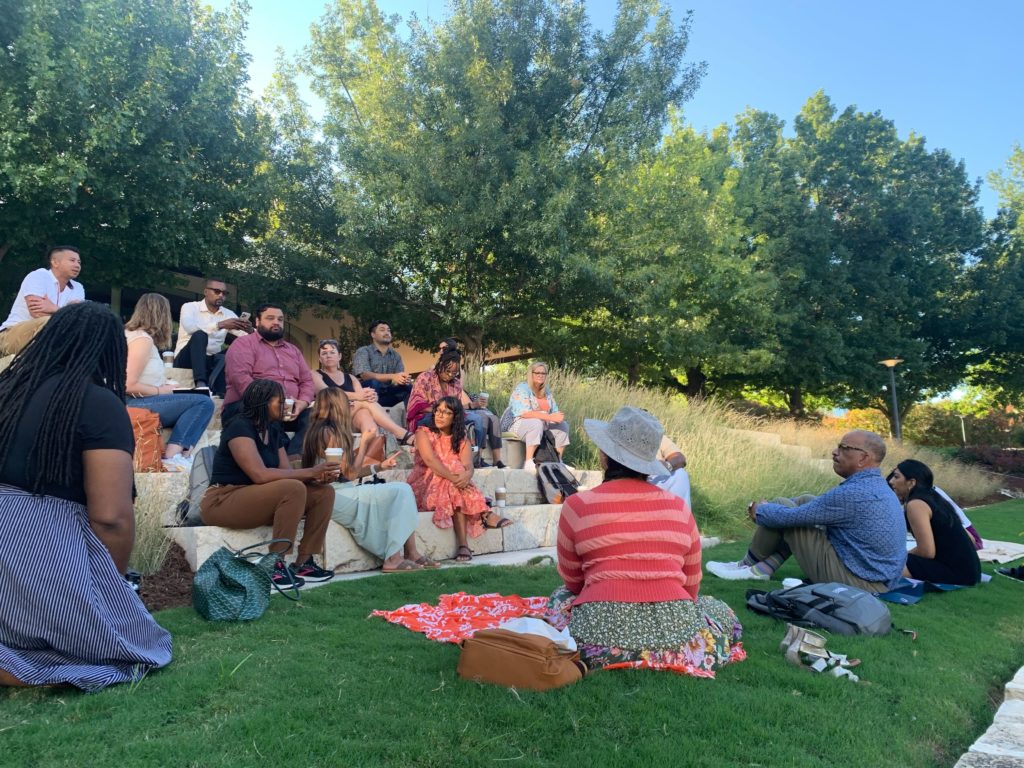BY Jessica L. González Martínez, New Growth Innovation Network and 2022 PLACES Fellow
I debated for a while about how I wanted to share the experience I had in Oklahoma City. So much rustled in my head regarding opportunities lost and opportunities forged. Like most communities, there appears to be a centuries-long project of weaving and mending, movements and actions of healing coming to a pause, when building and innovation are placed where rest and relationship are needed. My reflections will primarily be focused on people, those who work each day to document their journey and lay down a foundation for their future. I will touch upon the unique dynamics of small-midsize cities and how OKC is among them to be bold, learn, and grow from how they consider an inclusive strategy to economic growth.
There is no better way to start than at the beginning with First Americans: the Indigenous people who inhabited these lands before the United States was established. They include the Apache, Caddo, Tonkawa, and Wichita tribes. There are also tribes with historical connections, such as the Comanche, Kiowa, Osage, Muscogee (Creek), and Seminole. Collectively, 39 distinct tribal nations reside in Oklahoma. The Choctaw people call the land Okla Homma, meaning “red people,” the place these nations call home (source: First Americans Museum). Over time, the U.S. government forced individual land allotments among Indigenous people, which began to establish adjacent communities with Black Americans of former slave descendants, and those looking for a “promised land.” It has been recorded by the Oklahoma Historical Society that more than fifty identifiable All-Black towns were established between the end of the Civil War and 1920. It’s important to mention the deep, long history between these two groups as they continue to resurrect and heal, and how their familiarity with each other unfolds as time passes.
As I explored the city, remnants of the original land stewards were vividly present. Their stories were told by foreign voices celebrating the importance of Indigenous people, but never their contribution on what makes this land sacred. Storytellers marveled with excitement over the region’s ability to manage their mineral production of oil and gas, leading to the economic wealth that attracted more people to settle in the area. This made the area an attractive destination for migrants and immigrants.

My recollection above touches upon a small portion of the cultures that are now present and call OKC home. Investment strategies, such as the voter-approved penny sales tax initiative to bolster neighborhood and community need, haves supported opportunities for community voice and design for the future of OKC. In its fourth iteration, MAPS 4 is positioned to expand what has been visible redevelopment in infrastructure, beautification, and community reinvestment throughout downtown. Investments like these are giving hope to organizations like The Freedom Center, a historical landmark that was once home to the NAACP Youth Council and OKC’s civil rights movement. An investment of $25 million dollars is affording not only the restoration of The Freedom Center but also the creation of a new Clara Luper Civil Rights Center, honoring the contributions made by Clara Luper in championing civil rights.
As an economic developer, I had a keen eye toward The Freedom Center project. As the tour bus drove along North Martin Luther King Avenue, I began to see the difference between deployment strategies made from the initial onset of the MAPS tax investment, and the latest iteration. Now, I recognize being exposed to a small portion of the program’s history, and it’s clear to me that I have questions about what’s to come during and post MAPS 4. A visible difference can be seen, and felt, from how MAPS began revitalizing downtown, and now expanding deeper to other city limits. Here are my questions moving forward:
- What additional investments will be leveraged to help support surrounding communities adjacent to The Freedom Center?
- Will there be additional considerations for housing, transportation infrastructure, workforce, and small business pathways to those being served and supported through the center’s programming?
- How will a newly focused effort to support neighborhood and community needs help frame future redevelopment efforts and inform other city investments? Will there be a desire to add additional community-led processes across other city services?
- Will there be plans to connect downtown to areas like The Freedom Center, which expands transportation access and increases opportunities for workers and businesses alike?

Ultimately, OKC is one of many small-midsize cities that continue to face a myriad of challenges while being openly innovative in attempting to figure out solutions. As they manage through constraints of strengthening their capacities, they are also building a more profound understanding of what it truly means to drive equity and inclusion in their efforts to be competitive in a global market, while maintaining livability and opportunity for their residents. As cities incubate solutions, we must press forward and explore how we can galvanize behind their efforts and continue to strengthen the impact of driving inclusive economic strategies, which measure against outcomes that uplift communities across race, gender, and geographic lines. We are past small tables in small rooms. Now is the time to not only be inquisitive, but also challenge ourselves and the work we are putting into examining how we are serving alongside people and place. Not for the sake of progress, but for the boldness of reshaping community design through the leadership of Black and Indigenous voices.
About the Author
 Jessica L. González Martínez is senior advisor and co-lead for the Inclusive Recovery Initiative project at New Growth Innovation Network. Jessica leads a national community of practice of regional economic organizations working to implement inclusive economic strategies as well as supports insights and innovations which aim to generate deep insights through original research and design innovations to advance the field of inclusive economic development. Jessica brings experiences across workforce, community, and economic development which build upon solutions that work alongside people and the places they reside. She holds a MPA from Arizona State University and a B.S. in American Studies & Sociology from Rutgers University. The is a member of TFN’s 2022 PLACES Fellowship cohort.
Jessica L. González Martínez is senior advisor and co-lead for the Inclusive Recovery Initiative project at New Growth Innovation Network. Jessica leads a national community of practice of regional economic organizations working to implement inclusive economic strategies as well as supports insights and innovations which aim to generate deep insights through original research and design innovations to advance the field of inclusive economic development. Jessica brings experiences across workforce, community, and economic development which build upon solutions that work alongside people and the places they reside. She holds a MPA from Arizona State University and a B.S. in American Studies & Sociology from Rutgers University. The is a member of TFN’s 2022 PLACES Fellowship cohort.
